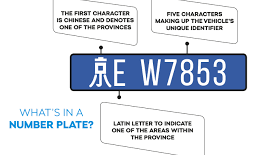Understanding 鲁Q 669FD: Regional Identifier and Its Significance
The alphanumeric code “鲁Q 669FD” might appear as just another vehicle license plate to the average observer, but to those familiar with Chinese vehicle registration systems, it holds a deeper geographical and administrative meaning. In China, license plates serve more than just the role of identification; they are embedded with regional, legal, and operational significance that helps regulate the country’s immense automotive ecosystem. The “鲁” prefix refers to Shandong Province — a coastal region in Eastern China known for its rich history and industrial power. The letter “Q” following the provincial identifier pinpoints a specific sub-region or city within the province, often related to traffic jurisdiction and local governance.
The numeric and alphabetic tail “669FD” acts as the vehicle’s unique identifier, and when taken together, 鲁Q 669FD becomes a powerful tool for regional traffic monitoring, law enforcement, and logistical control. This system not only helps in managing local transportation policies but also aids in enforcing regional rules, especially regarding emissions, traffic violations, and road taxes. Understanding this structure is essential for automobile owners, transporters, and anyone engaging with Chinese transportation infrastructure.
The Breakdown of 鲁Q 669FD: What Each Part Means
To truly comprehend the value and meaning behind 鲁Q 669FD, one must break down each element of this code. The Chinese license plate system is engineered for efficiency and quick identification:

Province Identifier (鲁)
“鲁” stands for Shandong Province. This character is derived from the historical name of the region and is used on all license plates originating from this area.
Regional Sub-Code (Q)
The letter “Q” denotes a particular city or region within Shandong. In many cases, this corresponds to a specific district, such as Weihai or Rizhao, but exact assignments can change as administrative needs evolve.
Serial Number (669FD)
This is a unique combination assigned to individual vehicles and is often randomized or sequential. It distinguishes one vehicle from another within the same administrative region.
This breakdown helps authorities and the public quickly determine the origin and registration details of a vehicle, ensuring seamless road monitoring and effective enforcement.
How Chinese License Plates Are Structured
The license plate system in China is one of the most advanced and structured systems globally, designed to cater to the world’s largest automotive market. Every license plate follows a uniform format that combines both local and national elements. The use of Chinese characters, Latin letters, and numbers provides a multi-layered approach to vehicle identification.

Types of License Plates
- Blue Plates: Standard for private vehicles
- Yellow Plates: For larger vehicles like buses and trucks
- Black Plates: Usually used by foreign-owned enterprises
- Green Plates: Designated for electric vehicles (EVs)
Each type of plate follows the basic structure: [Province Character] + [Letter for City/Region] + [Five-character Serial Number], which includes numbers and capital letters.
This system ensures quick readability for law enforcement officers and automatic license plate recognition systems used across toll booths and surveillance cameras.
Legal Importance of 鲁Q 669FD in Traffic Management
The legal framework surrounding license plates like 鲁Q 669FD plays a crucial role in maintaining public safety and order. Every vehicle registered under this system is subject to local laws and traffic regulations, and the license plate acts as a mobile extension of that accountability. Whether it’s identifying a speeding vehicle, tracing the origin of a car involved in a traffic violation, or managing congestion through plate-based restrictions, the license plate becomes a primary tool for governance.
Furthermore, the enforcement of emissions standards often hinges on the registration data tied to plates. Cities like Beijing and Shanghai restrict access based on vehicle type and registration zone. For example, a car registered with a 鲁Q code may face limitations when entering high-traffic urban zones without proper authorization or permits.
How Regional Identity Influences Vehicle Regulation
China’s regional diversity means that every city and province has unique road conditions, vehicle densities, and pollution levels. Hence, the regional aspect of the license plate — as seen in 鲁Q 669FD — directly affects vehicle regulation policies. Shandong, being an industrial and coastal province, often has stringent regulations about vehicle emissions, particularly in urban and coastal cities like Qingdao or Yantai.
For instance, vehicles registered under 鲁Q may undergo periodic environmental inspections and must comply with both provincial and national standards. Additionally, these vehicles might benefit from certain incentives or face penalties depending on regional development goals, such as reducing traffic congestion or promoting electric vehicles.
Technology Behind Modern License Plate Monitoring
The integration of technology with vehicle registration has revolutionized road safety and traffic control in China. License plates like 鲁Q 669FD are constantly monitored by high-tech systems, including:
Key Technologies Used:
- Automated License Plate Recognition (ALPR) cameras
- Artificial Intelligence-based traffic systems
- QR code-based vehicle data integration
- Satellite and GPS tracking for logistics
These systems enable real-time monitoring of traffic flow, capture violations, and even help in criminal investigations involving vehicles. For law enforcement, the license plate is the primary clue that leads to identity, location history, and legal status of the vehicle owner.
International Recognition and Cross-Border Regulation
As China expands its Belt and Road Initiative and cross-border trade with neighboring countries like Russia, Mongolia, and members of ASEAN, license plates like 鲁Q 669FD play an increasing role in international logistics. Trucks and trade vehicles with such plates must conform to international vehicle identification standards and regulations to avoid legal hurdles at checkpoints and ports.
Moreover, certain agreements allow vehicles from China to operate in neighboring countries under specific conditions. The plate thus becomes not just a local identifier but a transnational permit of sorts, regulated by international treaties and monitored through customs integration platforms.
How to Trace or Verify a 鲁Q 669FD License Plate
For those involved in logistics, transportation, insurance, or even private citizens concerned about vehicle verification, it is possible to trace license plates like 鲁Q 669FD through official government channels. These services are usually offered via:
- Provincial traffic department websites
- Police and law enforcement databases
- Insurance verification platforms
- Third-party vehicle registration services
In most cases, a proper reason and legal authorization are required to access detailed vehicle information. However, basic verification — such as confirming if the vehicle is registered and active — can be done publicly in many regions
Cultural Impact of Vehicle Identity in Modern China
In urban Chinese culture, a license plate can symbolize much more than legality — it can indicate status, location, and even social class. Plates from premium cities like Beijing or Shanghai are often seen as status symbols due to their scarcity and cost. While a 鲁Q 669FD plate may not carry the same cachet, it still marks the vehicle’s owner as part of an industrious and rapidly developing province.
Certain number combinations are considered lucky or unlucky based on numerology. For instance, plates ending in “8” or “6” are seen as favorable, while others may be avoided. This cultural dimension adds another layer to vehicle ownership and identification in China.
Common Issues and Scams Related to License Plates
Like all systems, the Chinese license plate ecosystem is not immune to fraud and misuse. Counterfeit plates, registration scams, and illegal modifications are rampant in some regions. Plates like 鲁Q 669FD can be duplicated or altered to avoid tolls or hide criminal activity. This is why the government is increasingly adopting digital registration methods, including RFID chips and blockchain-based registries.
Motorists should always verify the legitimacy of their registration and stay up-to-date with local traffic authority guidelines to avoid penalties or vehicle seizure.
Five Key Takeaways About 鲁Q 669FD
- 鲁Q 669FD is a license plate from Shandong Province, China.
- “鲁” signifies the province; “Q” identifies a specific region within Shandong.
- The number-letter combination ensures each vehicle’s unique registration.
- License plates are vital tools for legal compliance, tracking, and traffic enforcement.
- Technological advancements and international trade amplify the plate’s importance.
Conclusion: Why Knowing About 鲁Q 669FD Matters
Whether you’re a vehicle owner, logistics expert, or simply an interested traveler, understanding what a plate like 鲁Q 669FD represents provides insight into China’s structured, efficient, and region-specific vehicle registration system. This plate is more than a metal tag—it’s a coded summary of geography, legal responsibility, and modern technology. As vehicle regulations become more intertwined with environmental, urban planning, and international logistics policies, being aware of the meaning behind such codes is increasingly valuable. The next time you see a plate like 鲁Q 669FD, you’ll know it speaks volumes about its origin, purpose, and governance.
Frequently Asked Questions (FAQs)
Q1: Can a 鲁Q 669FD vehicle be driven in other provinces in China?
Yes, vehicles registered with 鲁Q 669FD can legally be driven across all provinces in China. However, they must comply with local regulations, such as emission standards and traffic control measures.
Q2: Is it possible to change a 鲁Q plate to another regional code?
Changing a license plate’s region typically requires re-registration of the vehicle in the new province, along with appropriate documentation and approval from local authorities.
Q3: How do I report a suspected fake 鲁Q 669FD plate?
You should report it to the local Public Security Bureau (PSB) or traffic police department, providing details such as the location, time, and any evidence like photos or video.
Also Read This: PROCUREMENTNATION.COM CONTACT




